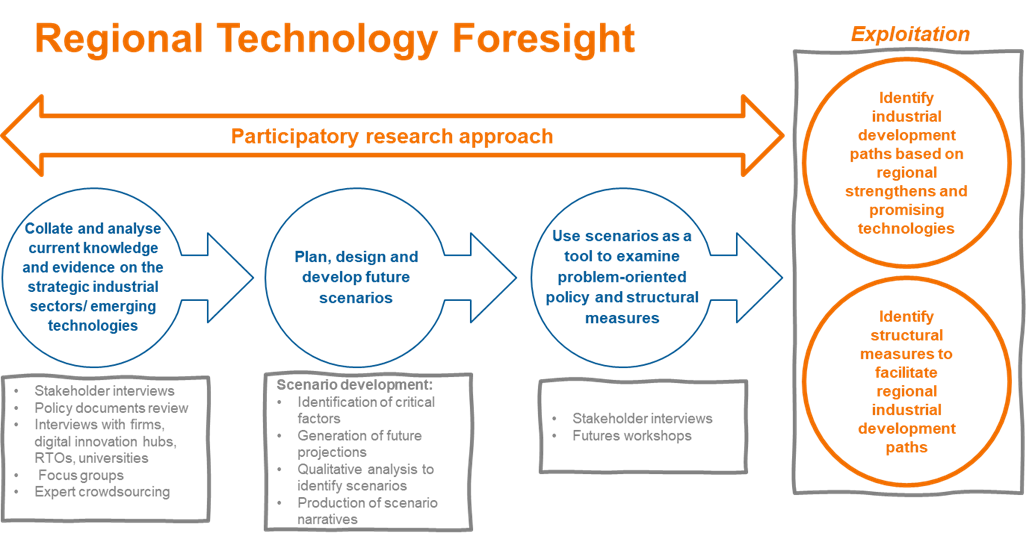Interreg Europe Policy Learning Platform organised an online discussion on Technology Foresight on Friday 25 February 2022. Technology Foresight can be seen as “a systematic exercise aimed at looking into the longer-term future of science, technology, and innovation in order to make better-informed policy decisions” (Pietrobelli and Puppato). The speed of technological change and the emergence of disruptive technologies continuously transform regional industrial structures.
As a result, Technology Foresight emerged as a tool to respond to this emerging complexity to foresee, shape and direct potential future orientation of technological change. This online discussion explored how regional policymakers can use Technology Foresight to involve a wide range of actors such as the public sector, experts, industry, and civil society to define and to prepare for a joint vision of the future.
Insights and takeaway messages
Foresight can serve to provide guidance in shaping innovation policies and can be used as a tool to support measures such as regional prioritisation, interregional networking and/or articulation of societal challenges (Nesta). Foresight exercises can reorient and update innovation policies while anticipating emerging technological changes and grand societal challenges (read also our article on Technology Foresight).
Regional Technology Foresight performs three main high-impact functions of informing, offering strategic counselling and facilitating:
- policy advice by emphasising a long-term perspective on transformative technologies;
- advocacy coalitions and an interaction space where the stakeholder community (firms, regional authorities; industrial technologists and industrial policy experts) co-develop a common vision;
- a social forum for strategic reflection, widening change capacities through enabling the transposition of foresight results towards policies and firms' exploitation of novel industrial technologies (see Jorge Tiago Martins’ presentation).

Figure 1. The Technology Foresight Process. Source: Jorge Tiago Martins, VTT.
Technology Foresight can offer a systematic methodological approach for the strategic design of S3. In STEPHANIE, Strategic planning through stakeholders’ involvement describes the methodology adopted for the strategic design of Tuscany’s Smart Specialisation Strategy (S3). The design methodology has involved regional stakeholders through a 5-step model for strategic planning that included (1) a foresight exercise by innovation poles on regional, strengths, weaknesses, opportunities, and threats (SWOT) to develop scientific and technological roadmaps, (2) external experts assessments of the roadmaps, (3) thematic workshops to validate roadmaps, (4) drafting the S3 with institutional contexts, priorities, and action plans, and (5) validation of the S3 by international peer regions. The S3 strategic design included many meetings, workshops, and sessions forming the core of the Entrepreneurial Discovery Process (EDP). The good practice highlights the importance to engage external experts to validate and legitimate strategic choices in the roadmaps and foresight exercises and limit vested private interests.
During the online discussion, the participants shared insights on how to involve stakeholders in Foresight exercises such as to:
- explain and communicate to stakeholders the importance of foresight exercises for the future of the region and its development.
- make the foresight questions as simple and as clear as possible for stakeholders.
- have clear rules of engagement and design the whole process from the beginning.
- provide feedback to stakeholders on their responses and how they were integrated in the construction of roadmaps/strategic visions.
- allow for open discussions among stakeholders and experts on strategic decisions.
- empower key stakeholders to communicate to other stakeholders and to lead foresight exercises.
The involvement of stakeholders in foresight exercises can be a starting point to build regional networks and to further engage stakeholders in the strategic and operational governance of the S3 and research and innovation initiatives and policy actions.
Policy Learning Platform Resources
- Read the article on Technology Foresight for Research and Innovation
- Have a look at our online workshop on Innovation for Societal Grand Challenges
- If you have any specific questions related to Technology Foresight, you can reach out to Policy Learning Platform experts directly via the policy helpdesk.
Image Credit: DIGITALREGIONS
![]()









